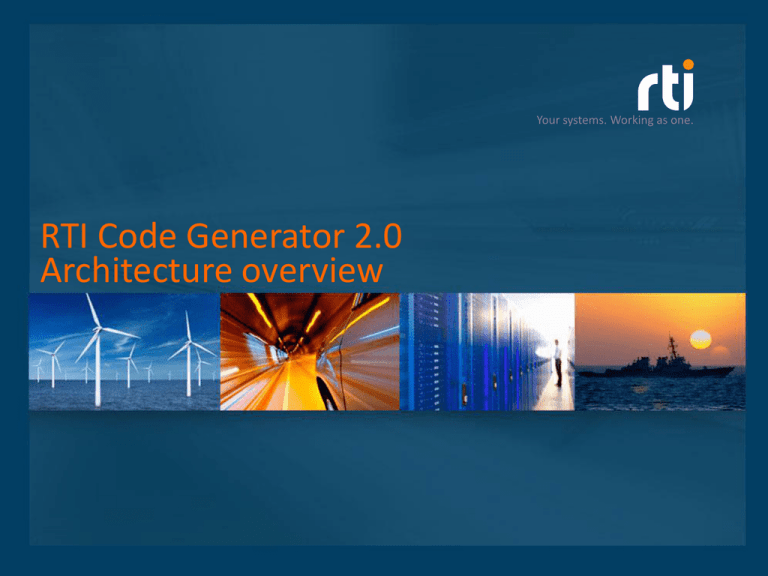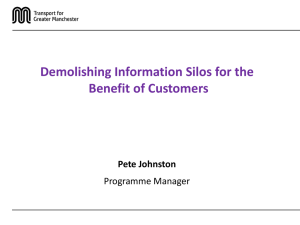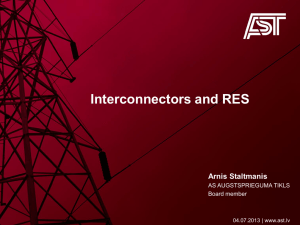RTI_rtiddsgen_architecture
advertisement

Your systems. Working as one.
RTI Code Generator 2.0
Architecture overview
© 2013 Copyright, Real-Time Innovations, Inc.
Why a New Code Generator?
• Performance
– Code generation with first rtiddsgen generation
(rtiddsgen 1) is slow for certain use cases
• XSLT parsing and loading is slow especially with large files
• Maintenance
– Internal:
• RTI is developing new features that require code generation
changes
• With rtiddsgen 1 is difficult to update existing XSLT templates
– External:
• RTI customers want to customize the generated code
• XSLT templates are not intuitive nor easy to customize
© 2013 Copyright, Real-Time Innovations, Inc.
2
New Code Generator Highlights
• Written entirely in Java
• Replaces XSLT templates with Apache Velocity
(VLT) templates
• Can avoid loading the JVM and recompiling
templates (when run in server mode)
• Is easy to customize: customers can change the
generated code by updating VLT templates
© 2013 Copyright, Real-Time Innovations, Inc.
3
Open Source Components
• rtiddsgen 2 makes uses three open source
projects:
– ANTLR (http://www.antlr.org/ ):
• To generate the parser
• To parse the IDL files
– Apache Velocity Template Language (VTL) used for
code generation (http://velocity.apache.org/):
• Velocity plugin for Eclipse eases editing of templates
– Log4j libraries for logging infrastructure
(http://logging.apache.org/log4j/1.2/)
© 2013 Copyright, Real-Time Innovations, Inc.
4
rtiddsgen 2: Architecture and Design
Code Generation Process Overview
preprocessor
Raw
Tree
AST
Tree
Emitters
VTL
Parsing
IDL/XML
ppDisable
(ANTLR)
Code
Templates
© 2013 Copyright, Real-Time Innovations, Inc.
5
Generation of the Abstract Syntax Tree
(AST)
• AST is an “in-memory” tree representation of
an IDL file
–
–
There are nodes for different IDL constructs (struct,
module, unions, …)
The AST is equivalent to the simplified XML generated
with rtiddsgen 1
AST
root
• Generation of the AST involves:
–
–
–
Parsing the file
• For this, we use the generated ANTLR parser
Creating the RAW Tree
• Tree obtained directly from the grammar
Creating the simplified tree (AST)
• From the RAW tree we obtain a simplified
representation
• This tree contains all the necessary information to
generate the code from the input files
• The emitters get information from this tree
Module
Struct
union
member
member
© 2013 Copyright, Real-Time Innovations, Inc.
Module
Struct
valuetype
member
member
member
6
AST Nodes
• Kind of nodes in the AST (all the nodes inherit from
IdlConstructTree)
–
–
–
–
–
–
–
–
–
–
IdlAliasTree: Inherits from IdlMemberTree
IdlConstTree
IdlDirectiveTree
IdlEnumTree : Contains IdlEnumeratorTree instances
IdlIncludeTree
IdlMemberTree
IdlModuleTree
IdlStructTree : Contains IdlMemberTree instances
IdlUnionTree : Contains IdlMemberTree instances
IdlValueTree : Contains IdlMemberTree instances
• Other classes
– IdlTypeKind
– IdlConstValue
© 2013 Copyright, Real-Time Innovations, Inc.
7
Templates: The Velocity Template
Language (VTL) (I)
• Example Part 1: Java Code
– Loading the Velocity engine and parsing the template
VelocityEngine ve = new VelocityEngine();
ve.init();
Template t = ve.getTemplate(“templateName.vm”);
– Creating the variables
ArrayList list = new ArrayList();
list.add(“Ribeira”);
list.add(“Cordoba”);
list.add(“Granada”);
– Creating the context and the writer
VelocityContext context = new VelocityContext();
context.put(“greeting", “Hello World");
context.put(“elements”, list);
StringWriter writer = new StringWriter();
t.merge(context,writer);
System.out.println(writer.toString());
© 2013 Copyright, Real-Time Innovations, Inc.
8
Templates: The Velocity Template
Language (VTL) (II)
• Example Part 2. Template Code:
– Variables (The variables are in the Velocity Context)
$elements = Ribeira Cordoba Granada
$greeting= Hello World
– Template:
#macro( printElements $elements)
#foreach($unit in $elements)
$unit #if($velocityCount<$elements.size()),#end
#end
#end ##end of the macro
Note: $velocityCount is a
Velocity internal variable whose
value is the loop count of the
#foreach loop starting at 1
$greeting,
Some cities from Spain are #printElements($elements)
– Output:
Hello World,
Some cities from Spain are Ribeira, Cordoba, Granada
© 2013 Copyright, Real-Time Innovations, Inc.
9
Templates: The Velocity Template
Language (VTL) (III)
• The VTL templates are intuitive to read because they resemble the file that
will be generated
• Code generation using Velocity involves:
– Loading the Velocity Engine
– Parsing the templates
– Creating the Velocity Context
• The context contains all the variables that the templates use
• When generating from the templates, Velocity will replace a variable with its value from the
Velocity Context
– Create the Writer
• The writer resolves the templates by merging them with the Velocity Context
© 2013 Copyright, Real-Time Innovations, Inc.
10
Templates: The Velocity Template
Language (VTL) (IV)
• Variable values can be of any type in the Velocity Context (string, list, map…)
– Variables are referred with this syntax “${variableName}”
• Control statements in the templates
–
–
–
–
#foreach. To access to each of the elements of a list.
#if, #elseif, #else.
Java methods can be invoked from the templates
You can use #macro to organize the code. The macros can be in the same file or in other
file, as long as it’s loaded in the emitter.
• Watch out for reserved characters:
– ‘$’ indicates the beginning of a variable.
• If you need to use this character, just make sure that you don’t have any variable named the
same than the string that is just after the ‘$’
– ‘#’ indicates the beginning of an instruction.
• If you need to use this character, replace it with the variable ${POUND_CHAR} that is included in
the Velocity Context by the code generator.
© 2013 Copyright, Real-Time Innovations, Inc.
11
Template Location and Organization
• Under resource/rtiddsgen/templates we can find one
folder for each of the languages.
• Inside each of these folders, we find the templates
necessary to generate code.
• These templates are divided in source code and utility
templates.
– The source code templates have most of the code that will
be output.
• Each source code template is directly associated to a source file.
– The utility templates contain utility logic (macros) that
assist in generating code
– For more information check
RTI_rtiddsgen_template_variables.xlsx
© 2013 Copyright, Real-Time Innovations, Inc.
12
Emitters
• The tasks of an emitter are:
– Loading the templates
– Getting the data from the AST and transform it into a
set of variables that will be used in the templates.
– Adding the variables to the Velocity Context
– Producing the output files by merging the Velocity
Context with the templates
• The EmitterManager is the object that creates the
emitters
– There is one emitter for each language
© 2013 Copyright, Real-Time Innovations, Inc.
13
Emitter Class Diagram
Contains methods to get templates
and emit the files (merge the Velocity
Context with the templates)
Contains methods to initialize
language-independent variables
Contains methods to initialize languagedependent variables
© 2013 Copyright, Real-Time Innovations, Inc.
14
Processing the tree
Java
Process AST
Node
C/C++
ADA
Process AST
Node
Process AST
Node
Store in
variable
Store in
variable
Set context
Set context
Set context
no
no
Is a
module or
top-level
type?
All nodes
procesed?
Emit files
Emit files
yes
Emit files
yes
Clean
context
Clean
context
© 2013 Copyright, Real-Time Innovations, Inc.
15
Server-mode Execution (I)
• Enhances performance significantly when processing many IDL files
• Server mode execution model
– Invoking rtiddsgen2_fast runs a native process which attempts to
communicate with the Java rtiddsgen process
• If this fails (which is always expected the first time), start Java rtiddsgen
process
– Pass command line options through a socket to the Java rtiddsgen process
– The Java rtiddsgen process:
• Parse IDL
• Parse Velocity templates
– These templates will now be cached by Velocity so this happens only when the template
is not in the cache
• Merge templates with IDL parse tree to generate files
– After an inactivity timeout (20 seconds), the Java rtiddsgen process exits
• Server mode script (rtiddsgen2_fast) uses the same command line options
as the rtiddsgen script (rtiddsgen2)
© 2013 Copyright, Real-Time Innovations, Inc.
16
Server-mode execution (II)
20 sec
creates
rtiddsgen_fast
Native
client
Java
TCP
server
rtiddsgen2.0
© 2013 Copyright, Real-Time Innovations, Inc.
17
Rtiddsgen2.0 Performance results (I)
© 2013 Copyright, Real-Time Innovations, Inc.
18
Rtiddsgen2.0 Performance results (II)
• Raw Performance Results
rtiddsgen 1.0
Many Small IDLs
One Large IDL
Customer's IDL
rtiddsgen 2.0
rtiddsgen.2.0
rtiddsgen 2.0_fast
improvement
62.676
30.4
58.377
29.453
54.721
28.819
56.372
29.57
60.966
30.086
rtiddsgen2.0_fast
improvement
2.73
5.63
2.85
5.64
2.90
5.51
3.02
5.75
3.23
6.54
C
C++
C++/Cli
Java
Ada
171.009
166.167
158.756
170.12
196.807
Total
862.859
293.112
148.328
2.94
5.82
33.406
34.269
31.321
34.043
40.137
2.219
2.161
2.003
4.291
4.267
2.286
1.249
1.002
1.197
3.131
15.05
15.86
15.64
7.93
9.41
14.61
27.44
31.26
28.44
12.82
Total
173.176
14.941
8.865
11.59
19.53
C
C++
C++/Cli
Java
Ada
272.718
269.307
249.551
258.838
317.636
105.001
104.006
99.654
103.467
104.128
50.027
48.442
47.871
53.29
51.535
2.60
2.59
2.50
2.50
3.05
5.45
5.56
5.21
4.86
6.16
Total
1368.05
516.256
251.165
2.65
5.45
C
C++
C++/Cli
Java
Ada
• Results obtained in x64Linux2.6gcc4.1.1. Rtiddsgen.1.0 is version of ndds500.rev08
© 2013 Copyright, Real-Time Innovations, Inc.
19
Rtiddsgen2.0 Performance Results (III)
• rtiddsgen 2 improves the performance of the rtiddsgen 1, both during
parsing and code generation
• With a large IDL file (2,000 structs) rtiddsgen 2 is 12x to 20x (server-mode)
faster
• With an actual customer use case, rtiddsgen 2 is 3x to 5x (server-mode)
faster
© 2013 Copyright, Real-Time Innovations, Inc.
20








